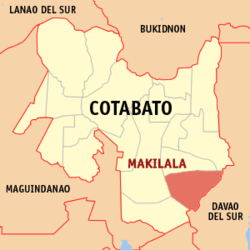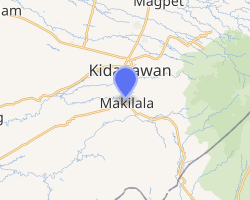Makilala
Makilala, officially the Municipality of Makilala (Hiligaynon: Banwa sang Makilala; Cebuano: Lungsod sa Makilala; Tagalog: Bayan ng Makilala), is a 1st class municipality in the province of Cotabato, Philippines. According to the 2015 census, it has a population of 83,851 people.[3]
Makilala | |
|---|---|
| Municipality of Makilala | |
 | |
 Map of Cotabato with Makilala highlighted | |
OpenStreetMap 
| |
.svg.png) Makilala Location within the Philippines | |
| Coordinates: 6°58′N 125°05′E | |
| Country | |
| Region | Soccsksargen (Region XII) |
| Province | Cotabato |
| District | 2nd District |
| Founded | September 8, 1954 |
| Barangays | 38 (see Barangays) |
| Government | |
| • Type | Sangguniang Bayan |
| • Mayor | Armando M. Quibod |
| • Vice Mayor | Ryan D. Tabanay |
| • Congressman | Rudy S. Caoagdan |
| • Electorate | 52,562 voters (2019) |
| Area | |
| • Total | 343.57 km2 (132.65 sq mi) |
| Population (2015 census)[3] | |
| • Total | 83,851 |
| • Density | 240/km2 (630/sq mi) |
| • Households | 19,170 |
| Economy | |
| • Income class | 1st municipal income class |
| • Poverty incidence | 32.16% (2015)[4] |
| • Revenue (₱) | 207,230,633.71 (2016) |
| Time zone | UTC+8 (PST) |
| ZIP code | 9401 |
| PSGC | |
| IDD : area code | +63 (0)64 |
| Climate type | tropical rainforest climate |
| Native languages | Hiligaynon Cebuano Tagabawa Ilianen language Obo language Tagalog |
| Website | www |
History
The Municipality of Makilala, formerly a barangay with a name of “Lamitan”,[5] was created by virtue of Executive Order No. 63 issued on September 8, 1954, by then President of the Philippines, Ramon Magsaysay.
The name Makilala is a portmanteau of the names of the early barangays of the area, namely: Malasila, Kisante, and Lamitan. An additional "la" was added to match the Hiligaynon word which means "to be known".
Geography
The municipality of Makilala is located on the south-east portion of Cotabato Province and the last town going to Davao City. It is bounded by the City of Kidapawan in the north, Municipality of M’lang in the west, Province of Davao Del Sur in the south and the Municipality of Tulunan in the south-east.
It is 129 kilometres (80 mi) from Cotabato City, 100 kilometres (62 mi) from Davao City, and 114 kilometres (71 mi) from General Santos City.
Barangays
Makilala is politically subdivided into 38 barangays. [2]
- Batasan
- Bato
- Biangan
- Buena Vida
- Buhay
- Bulakanon
- Cabilao
- Concepcion
- Dagupan
- Garsika
- Guangan
- Indangan
- Jose Rizal
- Katipunan II
- Kawayanon
- Kisante
- Leboce
- Libertad
- Luayon
- Luna Norte
- Luna Sur
- Malabuan
- Malasila
- Malungon
- New Baguio
- New Bulatukan
- New Cebu
- Old Bulatukan
- Poblacion
- Rodero
- Saguing
- San Vicente
- Santa Felomina
- Santo Niño
- Sinkatulan
- Taluntalunan
- Villaflores
- New Israel
Climate
Makilala's climatic condition is characterized by rainfall evenly distributed throughout the year, thus, the springs kept flowing, rivers are alive and farms are productive. The slopes of Mt. Apo, Mt. Libadan, Mt. Gap and Mt. Naponggis serve as rain generators that provide reliable rainfall pattern and cool climate.
| Climate data for Makilala, Cotabato | |||||||||||||
|---|---|---|---|---|---|---|---|---|---|---|---|---|---|
| Month | Jan | Feb | Mar | Apr | May | Jun | Jul | Aug | Sep | Oct | Nov | Dec | Year |
| Average high °C (°F) | 29 (84) |
29 (84) |
30 (86) |
31 (88) |
29 (84) |
28 (82) |
28 (82) |
28 (82) |
29 (84) |
29 (84) |
29 (84) |
29 (84) |
29 (84) |
| Average low °C (°F) | 20 (68) |
20 (68) |
20 (68) |
21 (70) |
22 (72) |
22 (72) |
22 (72) |
22 (72) |
22 (72) |
22 (72) |
21 (70) |
21 (70) |
21 (71) |
| Average precipitation mm (inches) | 51 (2.0) |
41 (1.6) |
38 (1.5) |
45 (1.8) |
82 (3.2) |
108 (4.3) |
114 (4.5) |
120 (4.7) |
95 (3.7) |
96 (3.8) |
76 (3.0) |
52 (2.0) |
918 (36.1) |
| Average rainy days | 13.2 | 12.0 | 13.8 | 15.3 | 22.5 | 23.9 | 25.2 | 25.4 | 23.3 | 24.1 | 21.0 | 16.8 | 236.5 |
| Source: Meteoblue [6] | |||||||||||||
Demographics
|
| |||||||||||||||||||||||||||||||||
| Source: Philippine Statistics Authority[3][7][8][9] | ||||||||||||||||||||||||||||||||||
In the 2015 census, the population of Makilala, Cotabato, was 83,851 people,[3] with a density of 240 inhabitants per square kilometre or 620 inhabitants per square mile.
Economy
Industries in Makilala are Rubber Industry, Woodworks and Agri-industrial products.
Major firms are STANFILCO-DOLE, engaged in cavendish production and rubber processing companies like STANDECO, FARMA, MRDI, PIONEER, LASRI, MRI, and DAVCO. Major wood processing company is RNF Summit. Also Makilala has First Community Radio Fm station Freedom Radio Makilala 107.9 fm
Their agricultural land mostly planted with rubber, rice, coconut, coffee, banana, vegetables and famous fruits such as durian, marang, rambutan and mangosteen.
Tourist attractions
- The foothills of Mount Apo, especially the area of Mt. Apo National Park which falls within Barangay Batasan, also contain several waterfalls, most of them hidden away in the old-growth forest within the National Park, while two of the tallest falls, Matibago and Padalagi, are visible from the National Highway. As of now there are no tourist-friendly access to these waterfalls, with them being several hours of hard trekking from the Barangays.
- The Barangay of New Israel is situated on the periphery of Mount Apo National Park at an elevation of 1,600 feet above sea level. New Israel was established by the Moncadistas, a religious sect. Aside from being a starting point for hikes up Mt. Apo, it is also home to a troop of monkeys, which are used to interact with humans, and New Israel Eco Park, with Asia's longest zip-line.
- Sang'ngawan Falls is found in the neighboring Barangay of Batasan. It is a collection of cold & hot natural pools, found beside the Malasila river. Its hot sulfuric pools are reputed to have healing effects.
- Le Reve Resort is located along National Highway, Makilala, Cotabato. It is an inland resort known for its use of unchlorinated spring water piped from the foothills of Mt. Apo
- Don Bosco Youth Camp, also located in Batasan, is a favorite venue for events like seminars, conferences, & weddings.
- Camps Cajelo and Aurora are found along the National Highway in Barangay Bulatukan. It is known as the venue for yearly Scouting events in the province.
- The access roads to the many barangays of Makilala also make for good mountain biking, with varying degrees of difficulty.
References
- "Municipality". Quezon City, Philippines: Department of the Interior and Local Government. Retrieved 31 May 2013.
- "Province: North Cotabato". PSGC Interactive. Quezon City, Philippines: Philippine Statistics Authority. Retrieved 12 November 2016.
- Census of Population (2015). "Region XII (Soccsksargen)". Total Population by Province, City, Municipality and Barangay. PSA. Retrieved 20 June 2016.
- "PSA releases the 2015 Municipal and City Level Poverty Estimates". Quezon City, Philippines. Retrieved 12 October 2019.
- "Archived copy". Archived from the original on 2011-05-07. Retrieved 2011-04-16.CS1 maint: archived copy as title (link)
- "Makilala: Average Temperatures and Rainfall". Meteoblue. Retrieved 30 January 2020.
- Census of Population and Housing (2010). "Region XII (Soccsksargen)". Total Population by Province, City, Municipality and Barangay. NSO. Retrieved 29 June 2016.
- Censuses of Population (1903–2007). "Region XII (Soccsksargen)". Table 1. Population Enumerated in Various Censuses by Province/Highly Urbanized City: 1903 to 2007. NSO.
- "Province of North Cotabato". Municipality Population Data. Local Water Utilities Administration Research Division. Retrieved 17 December 2016.
External links
| Wikimedia Commons has media related to Makilala. |